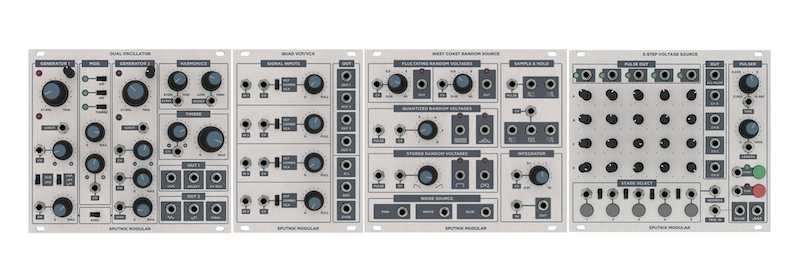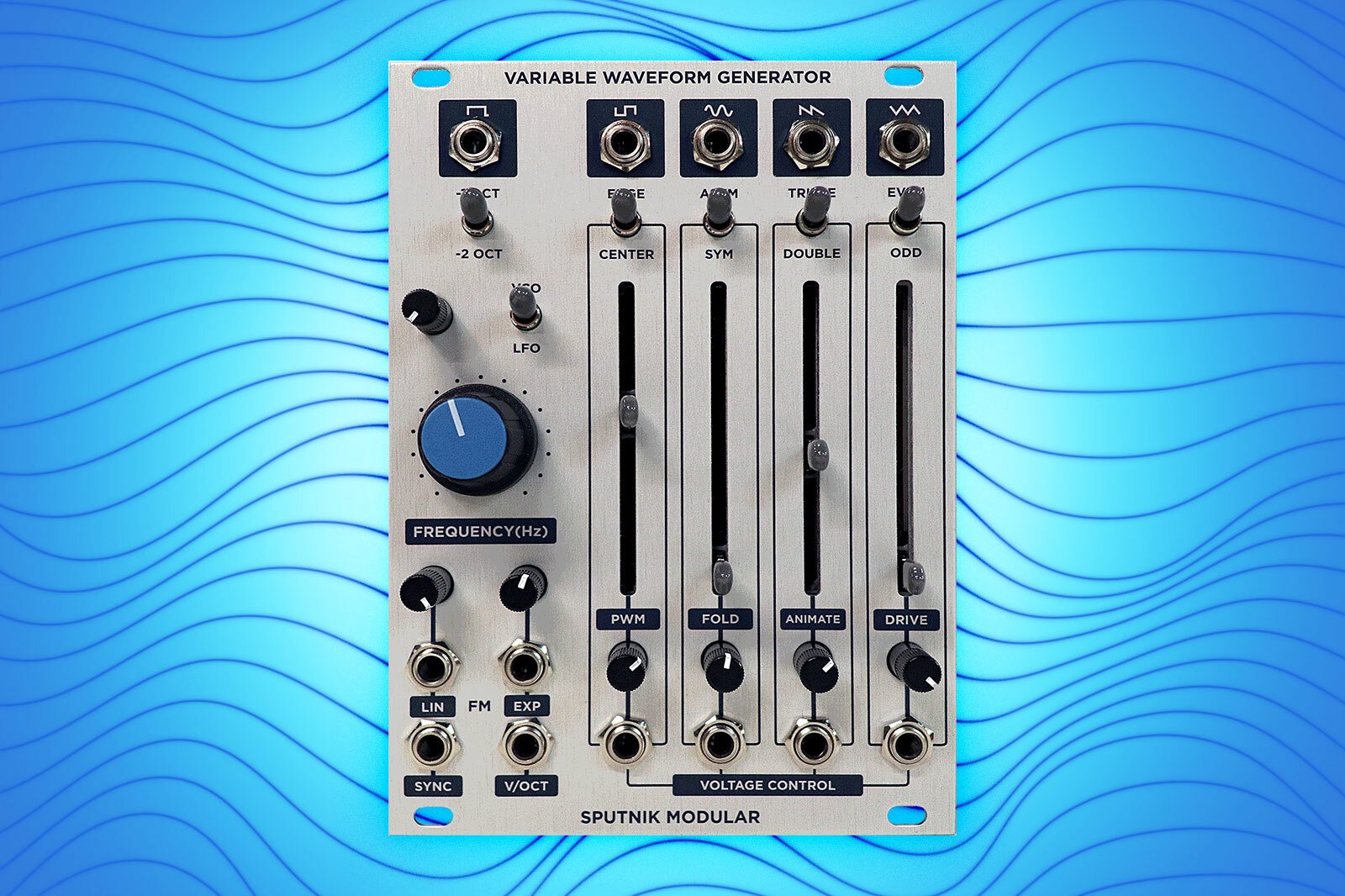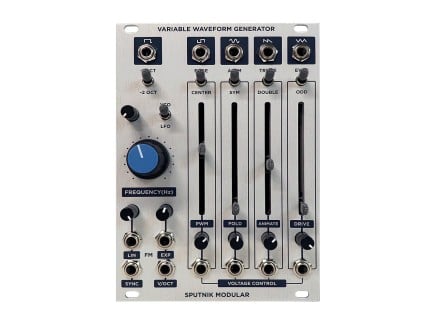Today marks an exciting new release for Eurorack modular synth enthusiasts—Sputnik Modular's new Variable Waveform Generator. This oscillator packs in a huge range of sounds, with a unique approach to waveshaping that sets it apart from the typical Eurorack oscillator.
It has been quite some time since we at Perfect Circuit have been able to play with any Sputnik designs, and we're quite excited to have them around again. Let's take a quick look at what's up with Sputnik Modular, and then dive into the details about their new release.
Sputnik Modular Then + Now
Sputnik Modular was originally started by designer Roman Filippov (now owner-operator of Black Corporation). Roman quite famously brought many of Buchla's 200 Series modules back to life around a decade ago as DIY projects—working from schematics, making best guesses, and examining real-life Buchla instruments in order to create kits so that enterprising DIY enthusiasts could, for the first time, build their own Buchla 200 system. Quite recently, Buchla USA called on him for his expertise in the field in order to bring back the 200 Series as ready-to-play modules in the original 4U format, a quite exciting prospect for those looking for a more immediate playing experience.

In the interim, though, Roman led another related project—Sputnik Modular, a company which produced clearly Buchla-inspired designs for Eurorack modular synthesizers. Unlike similar Make Noise or Verbos offerings of the era, most Sputnik designs were quite directly modeled on classic Buchla circuits (or, at least on Roman's 4U "clone" modules). Ultimately, for many, this became a clear way to get even closer to the fabled and desirable "West Coast" Buchla ethos than other alternatives. Rather than being "Buchla with a twist," Sputnik's offerings were near 1-to-1 Buchla work-alikes, providing an experience that many sought after.
Eventually, Sputnik ceased production of all Eurorack modules and traded ownership; however, we were intrigued to see last year's unexpected release of the Sputnik Spectral Processor, a remarkable module based on Buchla's 296 filter bank. Even that did not prepare us, though, for this newest release.
Sputnik's New Variable Waveform Generator
Sputnik's Variable Waveform Generator is a quite interesting departure from prior Sputnik designs altogether. Designed by Andrew Morelli (of Steady State Fate), the Variable Waveform Generator isn't a clone of a Buchla circuit—but it does draw clear aesthetic and sonic inspiration from oscillators found in the classic Music Easel and 259 Programmable Complex Waveform Generator. It's not a "complex oscillator" in the commonly-used sense: instead, it's a single oscillator with multiple, simultaneously-accessible, variable waveshape outputs designed to provide a huge range of options for generating sonic interest.
Let's look at the simplest features first. This oscillator features all the typical features you'd expect from an analog VCO: a large coarse frequency knob, small fine frequency knobs, dedicated linear and exponential FM inputs (each with independently variable modulation depth), a hard sync input, and a single 1V/Oct input. It offers a VCO/LFO range switch, and dedicated simultaneous outputs for triangle, saw, sine, square, and square suboscillator outputs (with selectable -1/-2 oct range for the suboscillator output).
That's all pretty straightforward; to be sure, that is quite a full complement of features, but I wouldn't be surprised to see these features on any old analog oscillator out there. What makes the Variable Waveform Generator special is its assortment of timbre-shaping controls, each with a long fader, a dedicated CV input with attenuator, and a dedicated mode switch. What's particularly interesting/unique, though, is that each of these impacts a specific output. This feels like something halfway between the approach of, say, Buchla 259-inspired modules (which often feature multiple simultaneous waveshape outputs, only one of which features continuous waveshaping controls), and the approach of the Arturia Minibrute, Microbrute, etc.—where each mixable shape features a dedicated timbre control specially-designed to work well with that shape. This is an interesting approach, in that even standard waveshaping methods like wavefolding aren't particularly interesting with every single sound source: a square wave through a wavefolder, for instance, is quite uninteresting compared to a sine or triangle. So in way, this is a lot like the "primary" oscillator in a 259-inspired "complex oscillator" module...but rather than having a single variable waveshape output, it has four. Let's take a look at what they do, one-by-one.
The square output's special timbre control comes in the form of Pulse Width Modulation (PWM), with multiple selectable flavors. With the two-way toggle switch set to Edge, this behaves exactly the way you'd expect a PWM control to work; it's worth noting, though, that the panel control won't get you all the way to 100% or 0% pulse width (it stops somewhere closer to 10% and 90% toward each end of the slider). This makes for huge, classic bass sounds. The Center mode, though, works a bit differently—rather than simply adjusting the proportional balance of high to low voltage in each cycle of the wave, it instead creates a three-level staircase-like waveform with variable width...creating a sound quite similar to PWM, but with a unique sonic flavor.
The sine output features a wavefolder, as you might expect from a module that takes influence from Buchla designs. There are two wavefolding flavors: Symmetrical and Asymmetrical. The Symmetrical folding mode operates the way you'd expect, introducing folds that equally impact the upper and lower boundaries of the sine waveform, yielding classic rich, warping modulation effects. The Asymmetrical mode is a bit more peculiar, affecting the upper and lower halves of the waveform differently from one another until the shape seems to "flatline" for certain parts of the cycle. This yields a somewhat more nasal, snarling sound, sure to be excellent for growling bass or atmospheric sounds.
The saw output offers an Animate control somewhat reminiscent of past "sawtooth animator" designs. This control features a three-way switch: in the middle position, the Animate control has no effect. In the Double position, you get an effect similar to having two simultaneous saw waves, whose phase can be offset from one another by varying the slider value (or using incoming CV). The Triple mode works similarly, adding two extra saw-like peaks to the basic waveshape, and offsetting their phase inversely from one another. This is a peculiar and unique effect, almost like the saw wave equivalent of PWM. It really shines when being continuously modulated, at which point you can approach supersaw-like effects without the need for multiple independent oscillators.
And finally, the Triangle output features a drive/distortion/soft clipping control. Switching between Even and Odd modes affects the intensity of the soft clipping, yielding slightly different shapes that accentuate different harmonics. This is a fairly gentle distortion sound, but it will prove quite useful for huge bass sounds that need to stay under control in a mix, or as a way of layering a thicker, rounder sound together with some of the brighter, more nasal sounds that other outputs can produce.
Shapes for Days
And of course—it bears repeating at this point that the Variable Waveform Generator can also act as an LFO, still providing four simultaneous outputs with all of these bizarre shaping parameters available. This could make for all manner of evolving, layered-yet-synchronous modulation, and I'm confident that it will provide just as much character as a modulator as it will a sound source.
I'm excited to see Sputnik producing original designs. While there's still certainly a place for more directly Buchla-inspired designs in the synth marketplace, the Variable Waveform Generator represents an exciting turn in the Sputnik product line. Andrew Morelli is a brilliant designer responsible for some of my favorite Eurorack modules, and see his take on a "West Coast" sound source feels much more fresh and exciting than another dual oscillator/waveshaper combo. This module certainly honors the legacy to which Sputnik Modular owes its footing—but it presents it in a new light, and it leaves me excited to see what is still to come.









